The Polaris Experience Center in Roseau, Minnesota, is a museum located at the Roseau Manufacturing and Assembly Plant. In addition to the museum experience, you can also take a factory tour. In the factory, you’ll see select models of Polaris off-road vehicles as well as snowmobiles.
What’s in the Polaris Experience Center?
The Polaris Experience Center opened December 7, 2001. It’s housed in a 5600 square foot area, so there’s lots of room for elaborate, full-size displays.

The Center curates the history of the Polaris company started by Snowmobile Hall of Fame co-founders, Edgar Hetteen (who later founded Arctic Cat) and David Johnson.
Hetteen and Johnson’s story begins in the 1940s and 50s with agricultural machines like their straw cutters, sprayers, and grain elevators. Then, in 1956, Johnson built their first snow machine.
How much did the first Polaris snowmobile sell for?
David Johnson built the very first snow machine for the struggling Polaris company. The local newspaper announced its arrival on Feb. 16, 1956, telling the story of how Johnson got the idea while wading through deep snow miles back to his hunting camp.
While the first Polaris was built for personal use, a lack of cash flow meant it had to be sold. David sold that first machine to H.F. “Pete” Peterson of Roseau for the whopping sum of $465.00.
Luckily for Pete, the inventors were on hand to fix and improve the snowmobile every time it broke down and he had to walk back to town!
Unfortunately, this first machine was destroyed in a fire some years later.
Polaris Treks Across Alaska
The fledgling company did various things to promote their snowmobile manufacturing business. However, it’s the Bethel, Alaska, to Fairbanks, Alaska, trek that’s the most amazing.
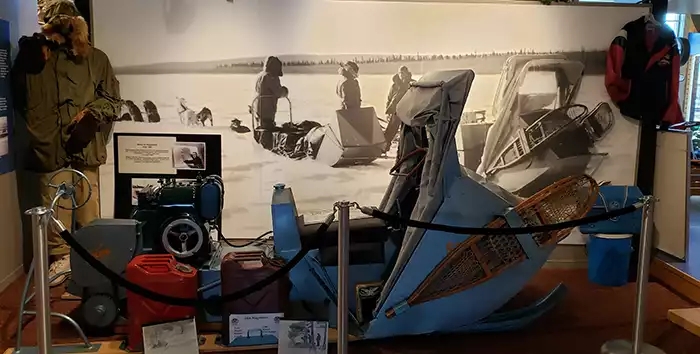
Hetteen’s epic 1960 journey launched the snowmobile as a real means of transportation. Three other brave snowmobilers accompanied Hetteen including Rudy and Bessie Billberg, and Erling Falk.
Altogether they traveled 1200 miles across the wilderness of Alaska with three Sno-Traveler snowmobiles. Two were 10-horsepower Rangers and the third was a 7-horsepower Trailblazer.
Bessie spent most of trek through unpopulated, unbroken wilderness standing on the back of a toboggan!
It took the team just twenty days on their Sno-Traveler snowmobiles.
By any standards, it was an amazing feat!
Polaris on the Racetrack
Polaris was highly successful on the race track, especially the years of their Starfire Kids and the Midnight Blue Express.
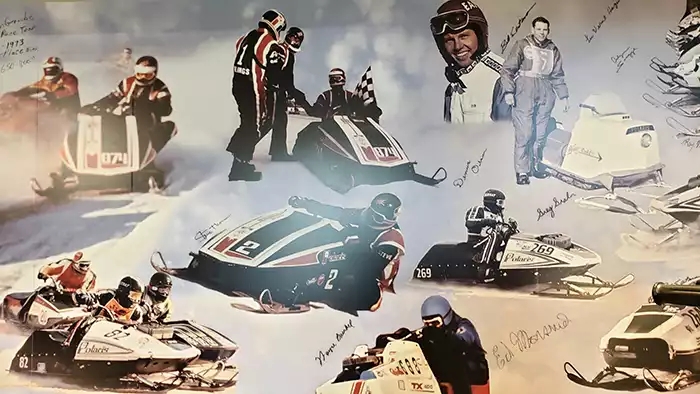
Snowmobile racing, particularly by the factory teams, brought a whole new form of excitement to spectators in the snow zone. In the early 1970s, there were dozens of snowmobile races every weekend. Polaris’s team won the lion’s share, earning them the nickname The Starfire Kids.
By 1977, Polaris was ready to set the world on fire. They had an all new machine to go with a new breed of drivers who’d learned from those Starfire Kids. That year, they went to even greater heights, and earned the new nickname of The Midnight Blue Express.
What percentage of professional races did Polaris win in the 1977-78 season to earn the name, Midnight Blue Express?
Polaris won 80% of all possible races that season! See the book that captures this history on Amazon.
Linda’s Pick of the Exhibits
While it’s hard not to have selected the trek across Alaska, with Bessie Billberg, as my favorite exhibit — I didn’t. Instead, I selected another group of dare devils: the Polaris Thrill Team.
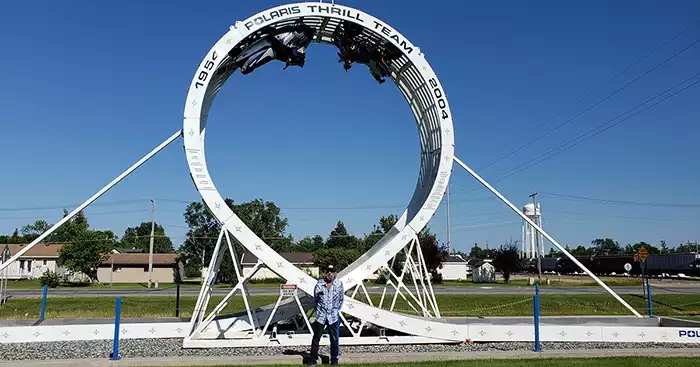
The 1960s might have been the crazy days of snowmobiling as well as the heydays! Indeed, the Polaris Thrill Team performed at major races across Canada and the U.S. through the late 1960s.
Of course, they didn’t use just any old Polaris models. The Thrill Team used specially built 373 Chargers to drive through, up, around, and out of the loop.
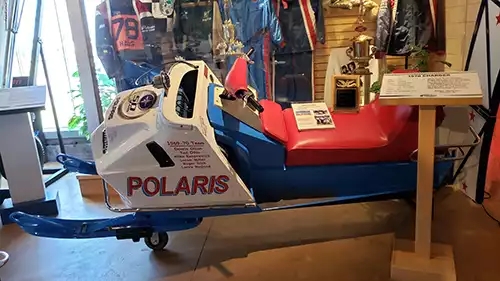
How fast did they have to go to produce enough G-force to stay in the loop? Top speed was around 34 mph!
Linda’s Road Trip Tips
We visited the Polaris Experience on a summer road trip to visit both the Polaris and Arctic Cat factories. We’d already visited the Ski-Doo Museum of Ingenuity and BRP factory a few years earlier.
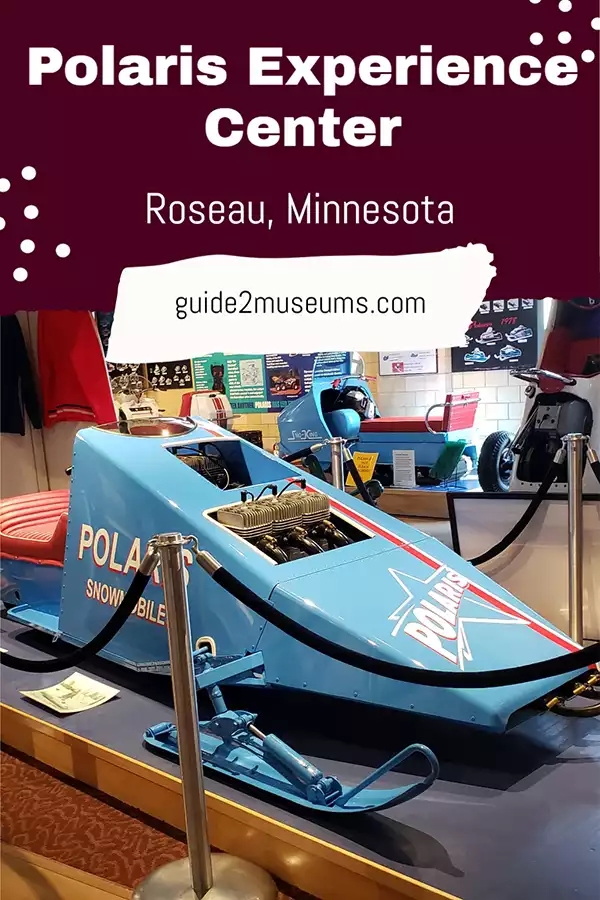
While the Polaris tour is better (you have your own headsets to listen to the guide), the Arctic Cat factory tour was also well worth a visit. It’s situated 75 miles south of Roseau, in Thief River Falls, Minnesota.
Before exploring the museum, we lunched at the Brickhouse Restaurant and Bar, which is in the same building. I recommend their wild rice soup (Wild rice is Minnesota’s state grain). We stayed at the inexpensive North Country Inn, which was all right.
The next morning we explored the Roseau Museum, which was well done.
Who Should Visit the Polaris Experience Center Museum?
The Polaris Experience Center does a great job of bringing the snowmobiling past to life — even if you aren’t already familiar with the sleds. It’s a given that it’s a must-see for snowmobilers, along with the factory tour.
Anyone interested in how winter transportation has changed since the invention of the snowmobile will also enjoy the exhibits. And for those who like daredevil stories, The Polaris Thrill Team and Trek Across Alaska are sure to please.
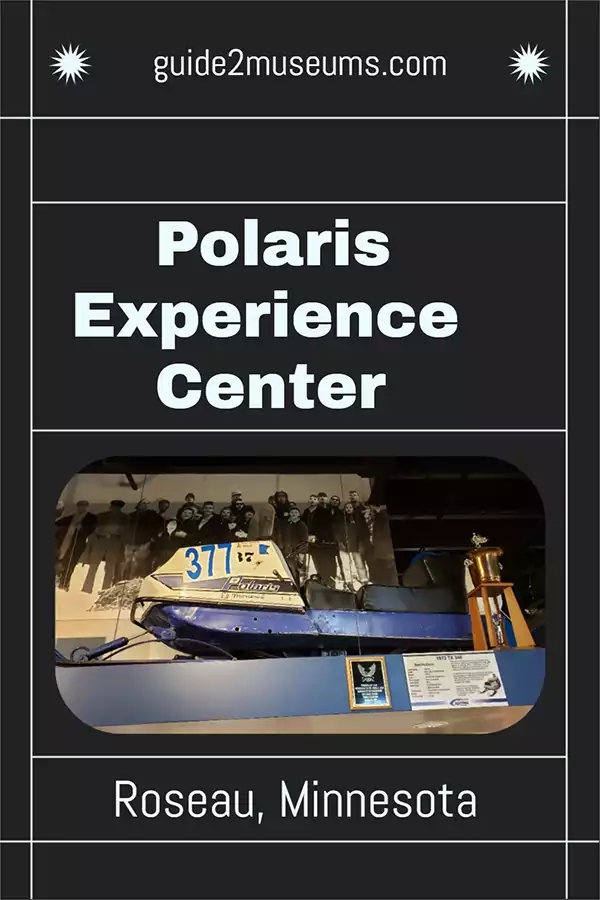
The museum is on a single floor, readily accessible for those with mobility issues. Kids will enjoy seeing the many artifacts, as they’re the focus, with the information boards as additional information.
How Do You Visit the Polaris Experience Center?
The Polaris Experience Center is located in Roseau, Minnesota, at 205, 5th Ave. SW. It’s north of the large manufacturing facility.
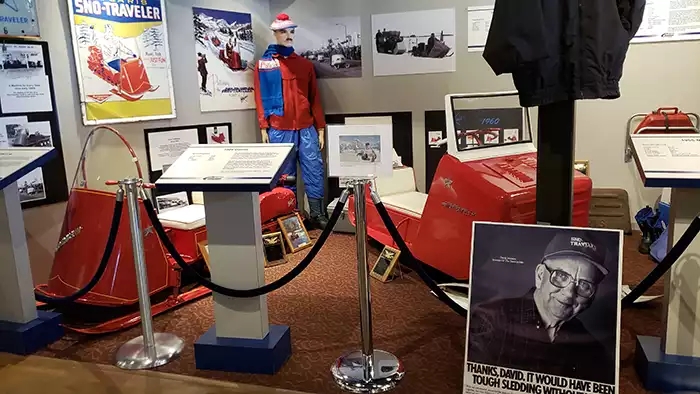
Check hours and days open at the Polaris Experience Center website.
Reserve your spot on a Polaris Factory Tour.
Take a virtual tour of the Polaris Experience Center and factory on YouTube.
Keep up-to-date with the Polaris Experience Center on Facebook.
Plan your visit with Google maps.
Discover More Snowmobile Museums
- Snowmobiles to Paul Bunyan: Wisconsin Museum
 The Vilas Historical Museum curates the history and artifacts of Vilas County, including the original first Eliason snowmobile. The collection also includes everything from dolls to lumberjack tools.
The Vilas Historical Museum curates the history and artifacts of Vilas County, including the original first Eliason snowmobile. The collection also includes everything from dolls to lumberjack tools. - Thrilling Speeds on Snowmobiles: WI Museum
 Eagle River, WI, is snowmobile central, whether you’re hitting the snowmobile trails or racetrack. This snowmobile museum has a great display of sleds and tons of information about every aspect of the industry.
Eagle River, WI, is snowmobile central, whether you’re hitting the snowmobile trails or racetrack. This snowmobile museum has a great display of sleds and tons of information about every aspect of the industry. - Surprising Story of Polaris Snowmobiles: MN Museum
 The Polaris Experience Center is a must-see for snowmobile enthusiasts. From the Midnight Blue Express to the Polaris Thrill Team, it’s a fascinating museum.
The Polaris Experience Center is a must-see for snowmobile enthusiasts. From the Midnight Blue Express to the Polaris Thrill Team, it’s a fascinating museum. - Ski-Doo Snowmobiles Jaw-Dropping History: QC Museum
 Valcourt, Quebec’s Museum of Ingenuity celebrates the innovations of J. Armand Bombardier and the company that was his legacy. See his original shop, tracked vehicles, and snowmobiles.
Valcourt, Quebec’s Museum of Ingenuity celebrates the innovations of J. Armand Bombardier and the company that was his legacy. See his original shop, tracked vehicles, and snowmobiles. - Notable Snowmobile Museum in Michigan’s UP
 The Top of the Lake Snowmobile Museum is in the small Michigan town of Naubinway. It’s collection has many unique machines with lots of information provided.
The Top of the Lake Snowmobile Museum is in the small Michigan town of Naubinway. It’s collection has many unique machines with lots of information provided. - Snowmobile Hall of Fame and Museum: St. Germain, WI
 The Snowmobile Hall of Fame and Museum is in St. Germain, Wisconsin. Displays include winning race sleds, vintage snowmobiles, gear, & memorabilia.
The Snowmobile Hall of Fame and Museum is in St. Germain, Wisconsin. Displays include winning race sleds, vintage snowmobiles, gear, & memorabilia.
Reference(s)
Brainerd Dispatch. (2001, December 21). Polaris’ new center in Roseau is an experience. https://www.brainerddispatch.com/sports/polaris-new-center-in-roseau-is-an-experience
Hetteen, E., & Lemke, J. (1998). Breaking trail. Bemidji, Minn: Focus Pub.









